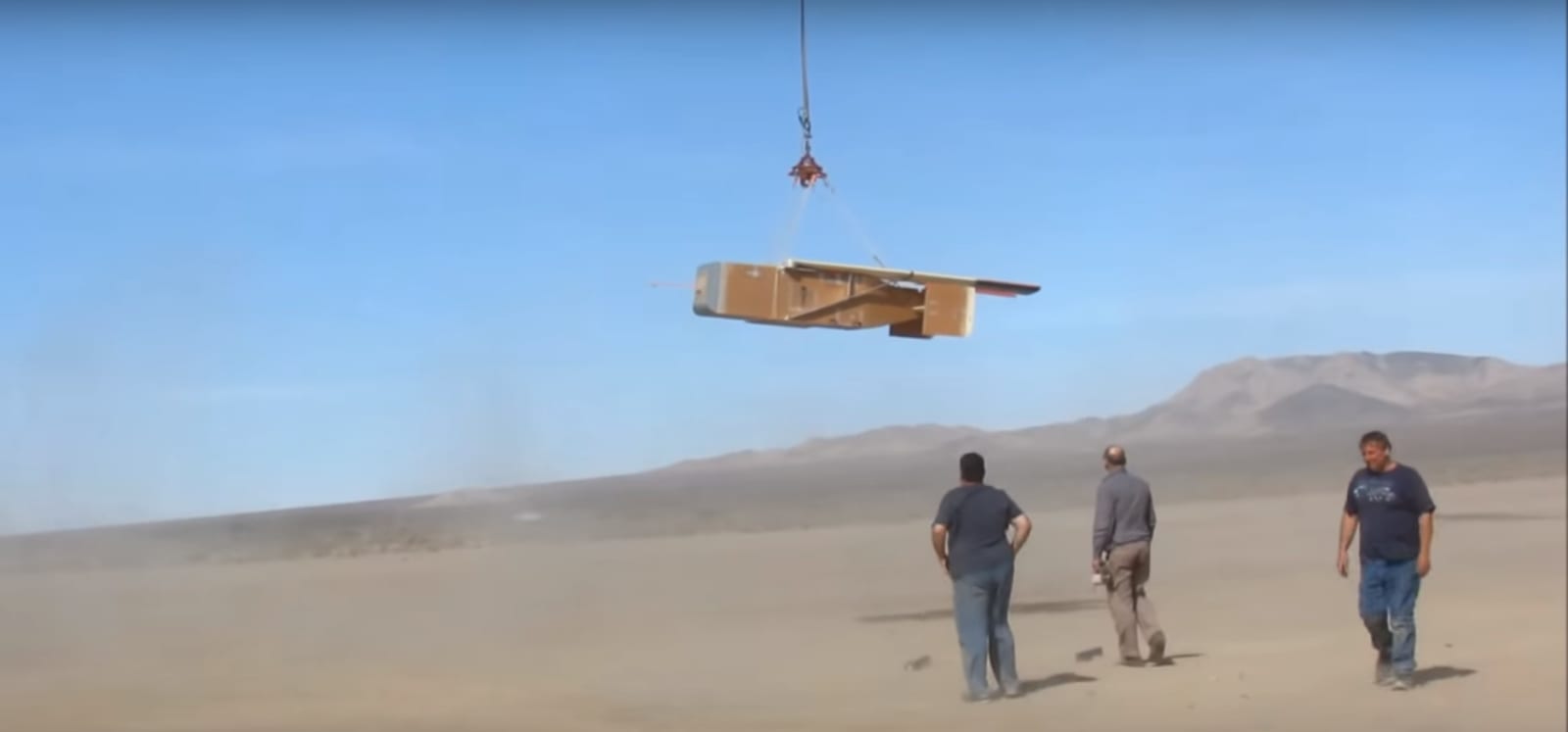Tag Archives: us military
Disposable delivery drones pass test with US Marines
 The US military is testing delivery drones that can transport supplies over long distances and be thrown away after each use. Made of cheap plywood, the bigger version of the two gliders being tested can carry over 700 kilograms, or roughly 1800 poun...
The US military is testing delivery drones that can transport supplies over long distances and be thrown away after each use. Made of cheap plywood, the bigger version of the two gliders being tested can carry over 700 kilograms, or roughly 1800 poun...
Cardboard Airplane Drone Doubles Traditional Drone Distance
U.S. Military Pact: Obama Arrives in Philippines to Sign Military Pact
Real-Life Iron Man Suit in Development by US Military
DARPA threat detection technology uses a camera to see targets, software and soldier brains to identify them
DARPA aids our military in myriad ways, from designing one shot, one kill weapons to creating robotic pack mules to carry soldiers' gear. It's also been building tools for soldiers to better survey their environment and identify threats, and its latest such tool is called the Cognitive Technology Threat Warning System (CT2WS). CT2WS is comprised of a 120-megapixel electro-optical video camera with a 120-degree field of view feeding a laptop running cognitive visual processing algorithms. Those algorithms identify potential targets in the video feed, which are shown to a soldier wearing an EEG cap that monitors brain signals. You see, the human brain is particularly good at perceiving threats, and CT2WS looks for the particular brain wave that occurs when we see one. The human component drastically improves the accuracy with which the system can identify enemies from afar. How accurate? Testing in desert, tropical and open terrain showed that without a solider/EEG filter, the system had 810 false alarms out of 2,304 threat events in an hour. Incorporating the filter resulted in only five false alarms per hour, plus it was able to identify 91 percent of the potential targets successfully. Not good enough, you say? Add commercial radar into the mix and the army becomes omniscient -- the system then identified 100 percent of the test targets.
Filed under: Misc
DARPA threat detection technology uses a camera to see targets, software and soldier brains to identify them originally appeared on Engadget on Thu, 20 Sep 2012 13:30:00 EDT. Please see our terms for use of feeds.
Permalink Extreme Tech | | Email this | Comments
Extreme Tech | | Email this | Comments Confirmed: AT&T offers complimentary unlock of in-contract iPhones for deployed military personnel
Finally. A bit of closure. AT&T has confirmed the long-lived speculation of its policy to unlock in-contract iPhones for our military men and women deployed overseas. To qualify for the complimentary service, active military members must have an account in good standing and provide the carrier with deployment verification -- that's it, no other hoops to jump through.
The revelation was made today as part AT&T's new Device Unlock Portal, which allows off-contract iPhone owners to apply online to have their handsets unlocked. Previously, this unlock service was available only through the carrier's retail outlets, online chat support or by dialing 611. As a quick rehash of the non-military policy, all users -- either current or former AT&T subscribers -- must have completed their contractual obligations to AT&T, and the phone cannot be flagged as lost or stolen. All those eligible should certainly apply for the service, as an unlocked iPhone is infinitely more useful when traveling abroad -- a reality that deployed military members know all too well.
[Military photo via Shutterstock]
Filed under: Cellphones, Wireless, Mobile
Confirmed: AT&T offers complimentary unlock of in-contract iPhones for deployed military personnel originally appeared on Engadget on Mon, 10 Sep 2012 21:07:00 EDT. Please see our terms for use of feeds.
Permalink PhoneArena, BGR |
PhoneArena, BGR |  AT&T | Email this | Comments
AT&T | Email this | Comments Jet That Could Fly Across USA in One Hour to be Tested

Remember the Concorde? The supersonic airliner that flew across the Atlantic at 1350 miles per hour, making the ocean crossing in 3.5 hours, twice as fast as most commercial flights these days?
Imagine doing it in an hour, flying at 3600 mph (maximum speed). Or flying from New York to Los ...
Continue Reading on Walyou
Military hunting smartphone safety to hold off enemy bugs, spooks
Ah, smartphones -- the delightful little slates carry our contacts, our content -- even our cash, and they still fit right in our pockets. No surprise then, that a lost or stolen phone can be a minor disaster -- or a major security risk (just ask the President). Now that soldiers are packing them to send GPS coordinates or situational images in the field -- on top of using them at home -- DARPA has enlisted security company Invincea to fortify the devices. Its first effort, encrypting OS files and filling the memory of a lost phone with worthless data, has already been deployed to 3,000 troops in Afghanistan. Its next target is to cloister apps into virtual rooms within the OS, locking off access to sensitive parts of the phone like its GPS or contact lists. That would keep any nasty bits of malware from potentially gaining root privileges so soldiers can fight, and Facebook, without compromise.
Military hunting smartphone safety to hold off enemy bugs, spooks originally appeared on Engadget on Sun, 24 Jun 2012 04:18:00 EDT. Please see our terms for use of feeds.
Permalink | New York Times | Email this | Comments
New York Times | Email this | Comments US military looking to create a ‘universal remote’ for drone fleets

When you've got as many different drone models as the US military, it can be hard to manage things. That's why a group inside the Pentagon is looking to help cut down on unmanned aerial fragmentation, attempting to develop a way to manage all of the different models with a universal drone controller. It's something the military has tried and failed to accomplish in the past, but this time it's taking a more smartphone-esque approach to the matter, according to Wired. The key would be to create an underlying software architecture that allows pilots to control fleets of unmanned vehicles. On top of that would be specific applications that are "down-loaded to suit individual user taste and productivity," a Pentagon official told the site. The approach would make it possible to control different models with differing functionality as a connected fleet.
US military looking to create a 'universal remote' for drone fleets originally appeared on Engadget on Mon, 18 Jun 2012 21:16:00 EDT. Please see our terms for use of feeds.
Permalink | Wired | Email this | Comments
Wired | Email this | Comments 

 Confirmed in a news post by the United States Military, America is working on an Iron Man-like suit that allows …
Confirmed in a news post by the United States Military, America is working on an Iron Man-like suit that allows …

